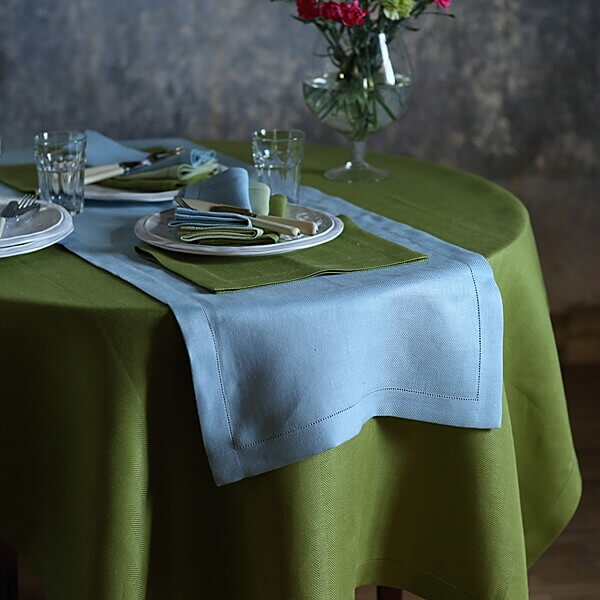Innovative Table Runner Uses: Beyond the Table
Innovative Table Runner Uses: Beyond the Table
Blog Article
Bed Linen Textile Advancements: Checking Out Modern Trends and Creative Applications in Style and Textile Industry
From lasting manufacturing approaches to sophisticated weaving technologies, the development of bed linen is reshaping the landscape of the fabric sector. As we delve right into the realms of innovative design applications and the introduction of bed linen blends and hybrid materials, a new chapter unravels in which bed linen's role in future fabric advancements takes facility stage.
Sustainable Practices in Linen Manufacturing
Lasting techniques in linen manufacturing have ended up being progressively important in the fabric industry's initiatives to decrease ecological effect and promote honest sourcing approaches. Bed linen, a natural fiber derived from the flax plant, offers a series of advantages such as breathability, resilience, and biodegradability. Nonetheless, standard methods of bed linen production can entail substantial water consumption, chemical usage, and energy-intensive processes.
To deal with these challenges, lots of textile manufacturers are taking on lasting practices throughout the bed linen manufacturing process. This includes sourcing flax from natural farms that avoid unsafe chemicals and chemicals, implementing water-efficient retting techniques to remove fibers from the flax stalks, and utilizing eco-friendly dyes and finishes. Additionally, some firms are purchasing renewable resource sources to power their production centers and decreasing waste with recycling and upcycling efforts.
Technological Improvements in Linen Weaving
With the growing emphasis on sustainable techniques in linen production, the textile market is now witnessing a rise in technological innovations particularly focused on transforming the art of linen weaving. These technologies are improving the method linen fabrics are created, using enhanced efficiency, high quality, and creativity in weaving methods.
One of the key technological advancements in linen weaving is the integration of digital looms. These innovative looms are furnished with software that allows for detailed and complicated styles to be woven with precision. By digitizing the weaving procedure, manufacturers can attain better uniformity and precision in their linen fabrics.
Additionally, advancements in yarn spinning innovation have actually allowed the production of finer and more resilient bed linen threads - table cloths. This causes softer and smoother bed linen fabrics that preserve their high quality also after several uses and laundries
In addition, the growth of eco-friendly dyeing processes and finishes for bed linen textiles is acquiring traction. These sustainable techniques not only minimize the environmental impact however additionally accommodate the boosting customer need for ethically generated fabrics.
Creative Design Applications for Linen
Ingenious creative strategies are increasingly shaping the innovative design applications for linen in the fabric industry. Linen's all-natural aesthetic appeal and capacity to mix with various other textiles make it a preferred choice for producing special garments and accessories that cater to the ecologically aware consumer.
Moreover, developers are trying out bed linen in home decor, using its breathable and sturdy nature to craft elegant home furnishings such as curtains, bed linen, and upholstery. The appearance and drape of linen bring a feeling of refinement and convenience to indoor rooms, including a touch of sophistication to contemporary homes.

Bed Linen Blends and Hybrid Fabrics

Crossbreed fabrics, on the other hand, take the principle of mixing a step better by including extra components such as metal strings, recycled materials, or conductive fibers. These ingenious fabrics not just expand the design possibilities but additionally present functional elements like conductivity, antimicrobial homes, or enhanced durability. Crossbreed textiles are significantly being made use of in different sectors, including style, interior decoration, and technical textiles, where the need for multifunctional products is on the rise.
Bed linen's Role in Future Fabric Innovations

In the world of future fabric technologies, linen is anticipated to be a principal in the development of sophisticated useful materials. Scientists and designers are exploring ways to improve linen's fundamental top qualities through technical innovations, such as incorporating wise fabrics, nanotechnology, and performance finishes. These innovations intend to boost bed linen's performance qualities, making it ideal for a broader series of applications, from activewear to protective garments.
Additionally, the combination of linen with various other all-natural or artificial fibers opens up endless opportunities for developing novel textiles with one-of-a-kind residential properties and functionalities. By leveraging bed linen's qualities and discovering innovative blends, the textile market is positioned to present exciting growths that cater to evolving consumer requirements and sustainability needs.
Final Thought
To conclude, the exploration of sustainable techniques, technological advancements, imaginative design applications, bed linen blends, and its function in future textile advancements highlight the continuous development of linen fabric in the modern description design and textile industry. With a concentrate on innovation and creativity, the flexibility and environmentally friendly nature of linen make it an important material for producers and designers alike, paving the method for additional growths and you can find out more innovations in the field of fabrics.
As we dig into the worlds of creative design applications and the appearance of bed linen blends and crossbreed materials, a new chapter unravels in which bed linen's role in future fabric developments takes center phase.
Exploring the fusion of bed linen with other materials has led to the emergence of cutting-edge blends and crossbreed fabrics in the modern fabric market. Bed linen blends supply an one-of-a-kind combination of the features of bed linen with those of various other fibers, resulting in fabrics that have boosted residential or commercial properties such as raised longevity, enhanced draping, and minimized wrinkling.The development of linen blends and crossbreed fabrics has actually set the phase for Linen to play a pivotal function in driving future textile developments.In the world of future fabric advancements, bed linen is expected to be a crucial player in the advancement of sophisticated functional textiles.
Report this page